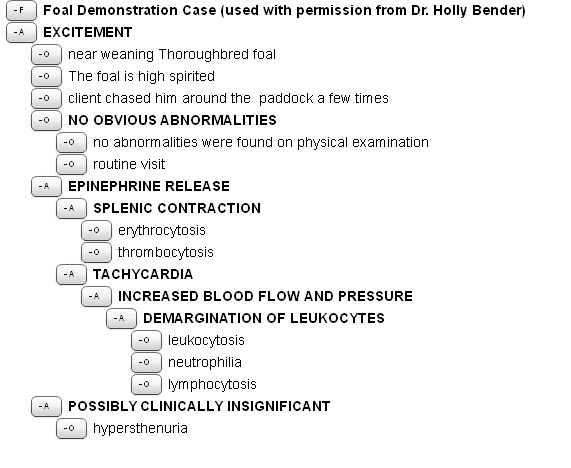Note: You can explore this example along with variations in educational scaffolding by selecting Examples in the Presenter component of the Platform. In addition, the Applied Learning Platform allows authors to use discipline-specific terms for an assessment such as Diagnostic path, Conceptual approach, etc.
The following scenario is from the domain of veterinary medicine and is explained in a way that can be understood by those with or without a medical background.
The scenario begins with you as a veterinarian being called to a stable to perform a pre-purchase physical examination on a foal. Unfortunately for you and all those concerned, this foal has no desire for intimate human contact, the least of which is ending up on the sharp end of a hypodermic needle.
The Physical Examination, Hematology and Urinalysis are what is the presenting information provided to you as a learner, and the Reference Assessment is the scenario author's thoughts on what is happening inside the foal from a physiological point of view.
What follows after the presenting information and the author's assessment is a discussion of the author's assessment as though it were constructed by a learner. This will give you an idea of how an assessment represents a learner's thinking.
As you move through this scenario and the discussion, I encourage you to think about your own domain along with its requirements for evidence-based assessment, and how scenarios and assessments could reflect your own understanding and learning objectives.


What does the above assessment indicate about this learner's thinking?
First, the learner's observations reflect an appreciation of the circumstances surrounding this scenario such as the nearly weened Thoroughbred foal being chased around the paddock. In addition, it was a routine visit, so the foal's owner was not aware of any illness or abnormalities. Some learners might miss these observations and immediately turn their attention to analyzing the laboratory data.
Second, the learner knows that being chased can lead to the release of epinephrine, which can cause the spleen to contract (splenic contraction) and the heart rate to increase (tachycardia). The assessment also indicates that the learner knows that a percentage of white blood cells (leukocytes, neutrophils, and lymphocytes) adhere to the walls of the vessels, and can be "washed off" (Demargination of Leukocytes) into the circulation by an increase in blood flow and pressure. This results in increases in their concentrations in the blood sample higher than when the foal is not excited. The learner refers to these increases as leukocytosis, neutrophilia, and lymphocytosis, which provides evidence of the learner's mastery of the domain vocabulary. A lower level of mastery would be indicated by an entry of "increased numbers of white blood cells" rather than the term "leukocytocis."
Third and perhaps even more important, the assessment indicates the learner's diligence in thoroughly reading the laboratory data and noting all abnormalities. It has often been said that, "More mistakes are made by not looking, than by looking and not seeing."
After considering all of this foal's relevant findings and constructing a assessment, the learner can now make the evidence-based assessment that this foal is suffering from the dreaded disease known as: Excitement. All laboratory values and the heart rate of the foal should return to normal once everyone leaves the paddock. The owner and veterinarian's heart rates should return to normal as well
Why is understanding what is represented in this assessment important for decision making?
The high Hematocrit (HCT) in the Hemogram of 52% (the concentration of red blood cells) might be mistaken to indicate dehydration if the learner did not understand the impact of splenic contraction and its high concentration of red blood cells. The high white blood cell count (WBC) of 21,500 might be interpreted to indicate an infection if the absence of BANDs (immature white blood cells) was not noticed. As a result, a veterinarian who did not have the understanding represented in this assessment might have given intravenous fluids and antibiotics to this foal unnecessarily.
In closing
While this scenario represents but one nuance in the analysis of laboratory data in the veterinary domain, one could easily imagine a series of scenarios that covered the major and minor concepts of virtually any domain. For example, if an agricultural extension group or medical team was sent to an impoverish country, they could have prepare beforehand by working through a series of scenarios constructed specifically for that region. In a similar manner yet a different domain, psychotherapists who are faced with learning a coding system such as the DSM-V for categorizing the mental/emotional issues of clients could benefit from a similar set of scenarios designed to illustrate significant differences among conditions. This is particularly important in the mental health field, because these types of "labels" are much easier to put on than take off.
Feel free to contact me if you want to discuss ways that scenario assessment could be used in your area of expertise.